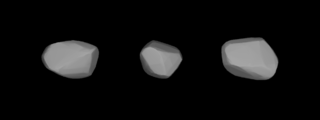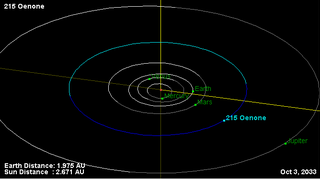126 Velleda is a main-belt asteroid. It is probably a rather typical, albeit sizable, S-type asteroid. Named for Veleda, a priestess and prophet of the Germanic tribe of the Bructeri. It was discovered by Paul Henry on November 5, 1872, in Paris, France. It was his first credited discovery. He and his brother Prosper Henry discovered a total of 14 asteroids.

153 Hilda is a large asteroid in the outer main belt, with a diameter of 170 km. The spectrum matches that of a P-type asteroid. It was discovered by Johann Palisa on 2 November 1875, from the Austrian Naval Observatory at Pula, now Croatia. The name was chosen by the astronomer Theodor von Oppolzer, who named it after one of his daughters. It is the largest member of the hilda family, a collisional family of asteroids in the Hilda region.

174 Phaedra is a sizable, rocky main belt asteroid that was discovered by Canadian-American astronomer James Craig Watson on September 2, 1877, and named after Phaedra, the tragic lovelorn queen in Greek mythology.

516 Amherstia was the 8th asteroid discovered by Raymond Smith Dugan, and was named after Amherst College, his alma mater. Amherstia is a large M-type main belt asteroid, with an estimated diameter of 73 km. It follows an eccentric orbit between Jupiter and Mars, with an orbital period of 4.39 years. The orbital plane is inclined at an angle of 13° to the ecliptic.

201 Penelope is a large main belt asteroid that was discovered by Austrian astronomer Johann Palisa on August 7, 1879, in Pola. The asteroid is named after Penelope, the wife of Odysseus in Homer's The Odyssey. It is orbiting the Sun at a distance of 2.68 AU with an eccentricity (ovalness) of 0.18 and a period of 4.381 years. The orbital plane is tilted at an angle of 5.8° to the plane of the ecliptic.

215 Oenone is a typical main belt asteroid. It was discovered by the Russian astronomer Viktor Knorre on April 7, 1880, in Germany, and was the second of his four asteroid discoveries. The asteroid is named after Oenone, a nymph in Greek mythology.

239 Adrastea is a main belt asteroid. It was discovered by Johann Palisa on 18 August 1884 in Vienna, and was named after the Greek nymph Adrasteia. This asteroid is orbiting the Sun at a distance of 2.97 AU with a period of 5.11 years and an eccentricity (ovalness) of 0.23. The orbital plane is tilted at an angle of 6.17° to the plane of the ecliptic.

300 Geraldina is a large Main belt asteroid. It was discovered by Auguste Charlois on October 3, 1890, in Nice. The origin of the name is unknown. It is orbiting the Sun at a distance of 3.21 AU with a period of 5.74 yr and an eccentricity (ovalness) of 0.057. The orbital plane is tilted at an angle of 0.73° to the plane of the ecliptic.

309 Fraternitas is a typical Main belt asteroid. It was discovered by Johann Palisa on 6 April 1891 in Vienna. The asteroid name is Latin for 'fraternity'; it was so named in order to commemorate the 25th anniversary of the Maturitätsprüfung Fraternity.

341 California is an asteroid belonging to the Flora family in the Main Belt. It was discovered by Max Wolf on 25 September 1892 in Heidelberg, and is named for the U.S. state of California. This object is orbiting the Sun at a distance of 2.20 AU with a period of 3.26 yr and an eccentricity (ovalness) of 0.19. The orbital plane is inclined at an angle of 5.7° to the plane of the ecliptic.

348 May is a large Main belt asteroid. It was discovered by Auguste Charlois on 28 November 1892 in Nice, and was named for the German author Karl May. This asteroid is orbiting the Sun at a distance of 2.97 AU with a period of 5.12 years and an eccentricity (ovalness) of 0.067. The orbital plane is inclined at an angle of 9.7° to the plane of the ecliptic. During its orbit, this asteroid has made close approaches to the dwarf planet Ceres. For example, in September 1984 the two were separated by 6.3 Gm (0.042 AU).

395 Delia is a large Main belt asteroid. It was discovered by the French astronomer Auguste Charlois on 30 November 1894 in Nice. "Delia" is an epithet for the ancient Greco-Roman Moon goddess Artemis, for her birthplace at Delos. This asteroid is orbiting the Sun at a distance of 2.79 AU with an orbital eccentricity (ovalness) of 0.085 and a period of 4.64 yr. The orbital plane is tilted at an angle of 3.35° to the plane of the ecliptic.
482 Petrina is a minor planet orbiting the Sun.

519 Sylvania is a minor planet orbiting the Sun in the main belt. It was discovered on 20 October 1903 by American astronomer R. S. Dugan at the Heidelberg observatory. The name is Latin for forest lands. 519 Sylvania is orbiting the Sun at a distance of 2.79 AU with an eccentricity (ovalness) of 0.186 and a period of 4.66 yr. The orbital plane is inclined at an angle of 11.0° to the ecliptic. This S-type (stony) asteroid has an estimated diameter of 48 km and is revolving with a period of 17.962 h.
711 Marmulla is an asteroid belonging to the Flora family in the Main Belt. It was discovered 1 March 1911 by Austrian astronomer Johann Palisa. The asteroid name may be derived from the Old High German word 'marmul', which means 'marble'. This asteroid is orbiting 2.24 AU from the Sun with a period of 3.35 yr and an eccentricity (ovalness) of 0.195. The orbital plane of 711 Marmulla is inclined at an angle of 6.1° to the plane of the ecliptic.
738 Alagasta is a main belt asteroid. It was discovered from Heidelberg on 7 January 1913 by German astronomer Franz Kaiser. The asteroid was named in honor of Gau-Algesheim, previously Alaghastesheim, which is the home city of the discoverer's family. This body is orbiting at a distance of 3.04 AU with a period of 5.29 years and an eccentricity of 0.055. The orbital plane is inclined at an angle of 3.53° to the plane of the ecliptic.
758 Mancunia is a minor planet orbiting the Sun. It was discovered in 1912 from Johannesburg by H. E. Wood, a Mancunian. This object is orbiting at a distance of 3.19 AU with a period of 5.70 years and an eccentricity (ovalness) of 0.15. The orbital plane is inclined at an angle of 5.61° to the plane of the ecliptic.
780 Armenia is a minor planet in the asteroid belt orbiting the Sun. It is named after the Kingdom of Armenia, now Armenia. This object is orbiting at a distance of 3.11 AU with an eccentricity of 0.097 and a period of 5.50 yr. The orbital plane is inclined at an angle of 19.1° to the plane of rotation. This asteroid spans a girth of ~94 km. The long rotation period of this asteroid necessitated light curve data from more than one latitude. The overlapping data provided a solution with a period of 19.891±0.002 h and a brightness amplitude of 0.18±0.03 in magnitude.
785 Zwetana is a minor planet orbiting the Sun that was discovered by Adam Massinger, an assistant at the Heidelberg Observatory, on March 30, 1914. It was named for the daughter of Kiril Popoff, a Bulgarian astronomer. This asteroid is orbiting 2.57 AU from the Sun with an eccentricity (ovalness) of 0.21 and a period of 4.12 yr. The orbital plane is inclined by an angle of 12.8° to the plane of the ecliptic.
796 Sarita is a minor planet orbiting the Sun. It was discovered 15 October 1914 by German astronomer Karl W. Reinmuth. This is a main belt that is orbiting at a radius of 2.63 AU with a period of 4.28 yr and an eccentricity (ovalness) of 0.32. The orbital plane is inclined at an angle of 19.052° from the plane of the ecliptic. Tholen (1989) initially classified it as type XD, although later authors treated it as an M-class body. The object's visual albedo is considered characteristic of the latter type. It has a significantly higher radar albedo than most main belt objects, which also suggests a higher metallic content.












